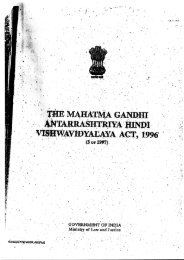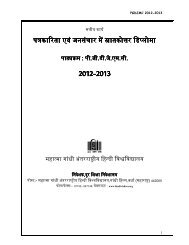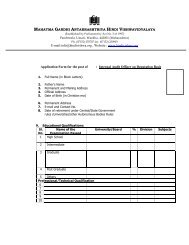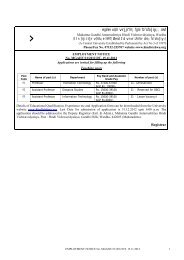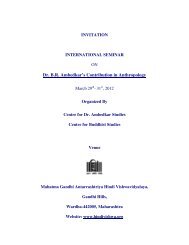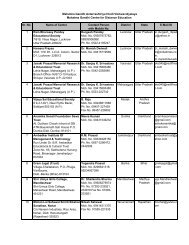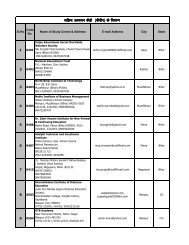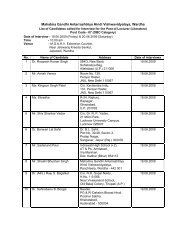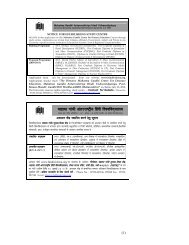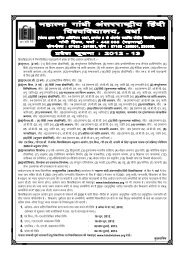- Page 1 and 2:
A Journal ofMahatma GandhiAntarrash
- Page 3 and 4:
LANGUAGEArundhati Roy in Indian Lan
- Page 5 and 6:
all is not well with the world. Ult
- Page 7 and 8:
After tallying the anubhavas mentio
- Page 9 and 10:
sustenance. If it fights shy of phi
- Page 11 and 12:
progression from Shringararasabhasa
- Page 13 and 14:
glamour and fame, I always looked a
- Page 15 and 16:
grandmother. Scolded for stealing t
- Page 17 and 18:
of his episodes and characters from
- Page 19 and 20:
The short story Najum (astrology) b
- Page 21 and 22:
India, Indianness and BuddhaDev Bos
- Page 23 and 24:
Buddha Dev Bose's writings on Tagor
- Page 25 and 26:
development of the idea of a worldl
- Page 27 and 28:
defies the set patterns of known li
- Page 29 and 30:
The Concerns of CriticismShambhunat
- Page 31 and 32:
On the basis of feudal thinking the
- Page 33 and 34:
etween the interests of different s
- Page 35 and 36:
silent about Hazari Prasad Diwedi.
- Page 37 and 38:
Imperialism. The imperialists had c
- Page 39 and 40:
conventional reformers to evaluatet
- Page 41 and 42:
expansion of knowledge emotions are
- Page 43 and 44:
unprincipled propaganda takes place
- Page 45 and 46:
drowning with shame or pride in it.
- Page 47 and 48:
made criticism a pure literary subj
- Page 49 and 50:
It is a great paradox that in an ag
- Page 51 and 52:
how much they are mixing with it. M
- Page 53 and 54:
peculiar way of protest against not
- Page 55 and 56:
Radha Worship in Hindi LiteratureL.
- Page 57 and 58:
valuable ornaments and clothes. His
- Page 59 and 60:
literature in general and Hindi lit
- Page 61 and 62:
Not only this the hunger which I go
- Page 63 and 64:
3. We the Janvadi PoetsWe are write
- Page 65 and 66:
5. A FarmerThis time paddy crophas
- Page 67 and 68:
isolated, lonely and stained with p
- Page 69 and 70:
3. A COFFIN AND A BOTTLEIn this roo
- Page 71 and 72:
The omnipresence of your super imag
- Page 73 and 74:
As I look at the black and white pr
- Page 75 and 76:
But when I touched the door of the
- Page 77 and 78:
7. LIFEThat day when I entereda mag
- Page 79 and 80:
2. TEA WITH DONNEGood Morning, dear
- Page 81 and 82:
4. HI, KRISHNA!Hi, Krishna!What’r
- Page 83 and 84:
Malbe Ka MalikMohan RakeshJai Ratan
- Page 85 and 86:
'Everything else has changed but no
- Page 87 and 88:
feet, on a brick path near the open
- Page 89 and 90:
ightened up on seeing Rakkha Pahalw
- Page 91 and 92: 'So what happened?''Nothing happene
- Page 93 and 94: Mad DelightMohan Rakesh was as much
- Page 95 and 96: In continuous rhythmic movements, h
- Page 97 and 98: is the silence within . . . silence
- Page 99 and 100: ehind. The man remains alone once a
- Page 101 and 102: stretching road ahead."And how much
- Page 103 and 104: the car."Tell me what do you want?"
- Page 105 and 106: "Was it necessary today itself ?" f
- Page 107 and 108: laughed father “not a morsel to e
- Page 109 and 110: Rites for The DepartedChandrakantaR
- Page 111 and 112: gazing at the swiveling waves of th
- Page 113 and 114: salutations to the Ganga : 'These p
- Page 115 and 116: He won his mukti in that instant of
- Page 117 and 118: a rush for a plank she suddenly see
- Page 119 and 120: The Voice Which was Progeny...Tarun
- Page 121 and 122: growl, blare and shouts had compell
- Page 123 and 124: Broken bamboos and thatches strewed
- Page 125 and 126: forest and open land. The man and w
- Page 127 and 128: "But I have already taken the money
- Page 129 and 130: Ramrath and Bhagirathi's fate gave
- Page 131 and 132: than their son.That boy knew this m
- Page 133 and 134: of power of the original to be tran
- Page 135 and 136: the time. "That raises a question i
- Page 137 and 138: The novelist was translating her ow
- Page 139 and 140: 13th paragraph, Arundhati used the
- Page 141: Referencesi. 'Arundhati Roy, transl
- Page 145 and 146: Sons published it under its Traditi
- Page 147 and 148: here that he forgot to smile.'"Afte
- Page 149 and 150: are the opulence of royalty, strugg
- Page 151 and 152: wide web (www) which has created ap
- Page 153 and 154: in it move beyond Cultural Studies
- Page 155 and 156: Prize. Wasn't it in the early years
- Page 157 and 158: deep insight into the life and work
- Page 159: 25. Ms. Kanan Jhingan, 48, Swastik



